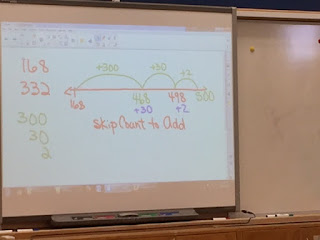In class this week we also looked at algorithms for adding and subtracting whole numbers. I was amazed to learn that there were actually additional methods of adding and subtracting numbers. Its funny because I was completely oblivious to the fact that basic math such as addition and subtraction could be taught in more ways than one and this is mostly due to the fact that growing up, I was only taught one way to formulate equations in school. In our class, we learned how to add and subtract using skip counting. I think that this alternative method of adding and subtracting is great because it not only gives students a different way to learn and understand the concepts of these processes but it also potentially provides students with a simpler way to calculate equations. For example, traditionally when subtracting whole numbers, we were taught to use borrowing. Many students have difficulty with the concept of borrowing and in my opinion it is not the best way of teaching subtraction and it is just one example of a method of teaching that has worked for some but will not work for everyone. The Image below displays an example of using skip counting to add: If a student has to add 168 to 332 they can place 168 on a line and turn 332 into 300 +30+2 when adding it to 168. Such as 168+300 =468 +30=498+2=500. See image below:

As educators we should be committed to providing our students with alternative algorithms so that they don’t have a false belief that there is “ only one way” to Add, subtract, multiply, and divide. With math scores and proficiency plummeting across the country there is a need for educators to provide students with the proper tools for success so that they can flourish in the future. Here is an interesting alternative algorithm video :)
Hey Kevin this post is very interesting and well done. You do a great job of explaining why it is important to give multiple algorithms instead of just forcing students to use one that they may not understand. I feel that this is a very important point in education that not many people understand and needs to be brought up in the conversation about education a lot more. I'm also very interested in the alternative algorithm that you posted onto this weeks post. From watching the video I would be interested to see other ways to teach multiplication and which way makes the most sense.
ReplyDeleteHi Kevin!
ReplyDeleteThis post really got me thinking about whether or not I would have developed more of an appreciation for math early on in my schooling if I was allowed to use different procedures and algorithms that better fit my learning style. I think the position that you are in is great in regards to the ability you have to really change how math can be taught in the classroom in this day in age. It is interesting to see how your outlook on math is changing because you, like many others, were taught in a way that promotes a closed mindset, but now you are being exposed to a more growth mindset of teaching math.
I hope you continue to learn more about better ways to teach math. Thank's for sharing!
Hello Kevin,
ReplyDeleteI enjoyed reading your post especially your point that every student learns differently and if there are no options then teachers “could be setting some students up for failure”. I most definitely can relate to this point as I was always the student that wanted to do the work in a different way. Like some students I am a visual learner and need to see how and why things work, it needs to make sense. Unfortunately “old school” math teachers frowned upon this type of venturing off into independent world. Math was always taught in a certain manner and an expectation that all students learn and retain the information in the same way. Thus creating a lot of stress, anxiety and fear of the subject for some students.
Each time I come to math class I find it funny that by simply presenting the algorithm in a different way it can have such a great impact on my attitude towards math. For example learning about skip counting or thinking about the number 168 as 100+60+8. I have never thought of looking at numbers in this way and for the first time it makes sense.
Hi Kevin,
ReplyDeleteAwesome post this week. The video at the end was really cool, I had heard of that method before but never applied it. I went to try out some problems with that method, while I found it time consuming, I thought it was really easy.
I really liked when you said "providing our students with alternative algorithms so that they don’t have a false belief that there is “ only one way” to Add, subtract, multiply, and divide." I completely agree. This way we can accommodate the different learners and make sure they are able to understand math more easily.
Keep it up!
Hey Kevin, I really enjoyed this blog post its interesting and engaging. The video at the end is different, I have never seen that applied before. I like how you talk about different algorithms because we all have different learning styles and ways of doing things. I think it's important for us as educators to embrace different ways of doing math and understanding that there is not just one right way of coming up with a solution in math but applying what works for us as individuals as long as it can be applied to more than one problem
ReplyDelete